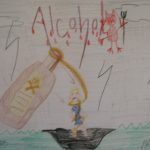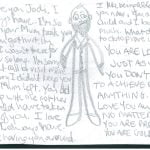
ADULT – As adults we have ADULTERATED our innocence (inner sense), changed it to fit in with others. Hence we don’t express ourselves. We behave – ‘be’ and ‘have’ what others ‘have’ and ‘be’ so that they feel comfortable around us.
ALONENESS – Many of us find it hard to spend time alone, especially in silence. We feel lonely and that feels like torture! This occurs when you don’t really like the person you are alone with – yourself!! As you heal and learn to accept and love yourself, spending time alone is great. You love the time to connect with your inner-self, to hear your thoughts, listen to your desires, to feel your feelings and to take action to create the life you want. You feel whole and connected to yourself, life and the universe. Hence aloneness becomes a beautiful experience of ‘All Oneness’.
ATONE – Some people talk about a need to atone for their sins. From a personal development point of view there are no sins – only learning opportunities. We learn that we don’t feel good about ourself when we do something that hurts others or ourself. We learn over time that hurting someone else just hurts me.
In this sense we are ‘at one’ with others. So to atone is to accept and live your life knowing that you are connected to others – that we are all one. Science shows that this is true in the sense that we are all breathing out dead cells and atoms from our body creating a soup of DNA, energy and information in the air. Each of us breathes some of this in and uses the atoms and energy in the air to create new cells in our body. Hence we all contain atoms and energy that have been in other people’s bodies. We truly are all connected! Spiritual authors also say that there is only one energy – that everything in the universe is made from this energy which is God – hence we are all ‘at one’ just experiencing life here on Earth.
BARGAIN – to bargain is to ‘bar gain’ from entering our life. Money can be seen as another way of expressing love. When we haggle down prices we are withholding love from those we are interacting with. We are coming from a focus on lack – a belief that there isn’t enough money or love so we need to be careful with it, stingy with it. We become reluctant to give and protect ourself. If everyone does this then the flow of money and love slows down. Life becomes more grim. Hence we diminish the likelihood that ‘gain’ will come into our life – when we don’t give freely we don’t receive freely! The world’s poorest nations are the ones where bargaining has become a way of life. Where withholding love from one’s brother has become the accepted norm and a cause of poverty. If you bargain down the price of an item from $100 to $80, then in your mind you will only value it as worth $80. Hence you lose out on $20 worth of enjoyment. Worse according to Peter Erbe author of God I am, you create an energy imbalance of $20 which means you will either lose the item, break it or experience some other loss or bill for the $20 plus interest later on. Peter claims that this is the universal law of compensation. He says that if someone offers you a discount without you asking then that is okay as you haven’t withheld your love – you still give freely what is asked. So to receive freely love, energy and all good things in life you have to give them away freely too. You have to trust the universe is abundant and will support you. Peter claims that whatever you do this with comes back to you in greater amount. However, if you give only so that you get more, it doesn’t work. You have to truly give freely with no expectation. This concept is a hard one for many of us who have experienced lack and poverty to swallow. However he claims and so do many others that it does work. The more you heal and accept yourself, you come from love. As you do this you see more love around you in the world. You realise that you don’t need material objects to make you happy and you’re happier with and grateful for whatever you do have. From this frame of mind it is easier to imagine giving freely and not being so self concerned, protective or self centred.
BEHAVIOUR – I change what I ‘be’ and ‘have’ to what ‘U R’ so that you will accept me. In doing so I lose contact with who I am. Often if we swallow what we would like to say or don’t do what we really would like to do, it feels horrible. It feels like a small death. In a sense it is. As every time we don’t honour our true self, we are dishonouring ourself. Internally we are flooded with ‘bad’ feelings – sadness or anger at ourself or the situation. We lose touch with our true self. We are all individuals and we are all therefore different. It’s meant to be that way!! Learning to love and accept yourself, to fully express yourself and to be who you really are at all times is part of your challenge here on Earth. It doesn’t matter what anyone else thinks about you – it’s only what you think about you that matters.
BELIEVE – What I ‘BE’ and ‘LIVE’ – knowing a concept like trust or self love is not worth much, it is only when you actually practice it in your life, that you really believe it.
CONFUSION – we are confused when we are ‘fused’ with our old beliefs which ‘con’ us into believing in lack, evil, scarcity – that the world is a harsh place. We may be set in our ways of thinking yet know that things aren’t working the way we want them to. We don’t know what to do about it – we feel confused. We need to un-focus from our old values and refocus on the greater reality – see the good in life. Confusion leads to a process of reorientation.
CRISIS – “Christ Is” – We learn and heal through crisis and pain. Without disruption to our lives many people would not take the time and effort to heal from their past hurts and focus on their personal growth – they try to ignore it and keep the past buried. Life is not going to be easy all the time. We all face challenges and can grow from them. Some people think they are being punished by God when something that they see as ‘bad’ happens to them. They’re not. It is a chance for growth. God, Christ, the Angels and Ascended Masters support us through such processes, helping us to find the strength to go on. This is aptly summarised in the saying “People turn to God when their foundations are shaking, Only to find that it is God who is shaking them”.
DEVIL – Denying Everything Valuable In Life – not seeing the perfection in everything – living life backwards – LIVED. Many of the personal development and spirituality authors believe that there is no devil. No such thing as evil. No judgement by God – only love and acceptance. It is we who judge ourself. It is we who create negative situations in our life by our thoughts and actions. If we get caught up in only seeing the negative in life we can spiral downwards into depression – it is our thoughts that create this. To overcome it we need to change our thoughts, start noticing and appreciating the good things that exist in the world and in our selves and our lives. Everything that happens to us occurs to help us awaken to love and let go of fear. If we don’t listen we have to attract larger lessons to help us. When you truly understand this and experience how it works and heal it becomes easier to see that everything is happening perfectly and the universe truly does support us – once we love and support ourselves!!
DISEASE – Dis Ease – when we are not at ease with ourself – we become ill. All dis-ease comes to us to help us realise something about ourself. To get our attention so that we wake up and change aspects of our life that are not in line with love and our highest good. Speak your truth, release buried emotions, heal, come from a place of love, do what you enjoy in life and you will be at ease. Choose to grow and develop – take action and do it – then you don’t need to attract in disease or other wake up calls.
DOUBT – Driving Ourselves Unconscious By Thinking – We are all beautiful human beings capable of doing amazing things. However many of us have been told or made to feel that we’re not good enough by other people. Unfortunately many of us now believe that about ourself. We may want to try new things, to change jobs, to start a new hobby or sport, but we feel doubt and fear and we allow this to stop us. The events themselves do not have any power – it is our thoughts about them – what we say to ourself that creates doubt and gives objects or people our power. In healing we learn to take our power back and to stop negative thoughts and self criticism. We learn to overcome doubt and fear and do things anyway. Knowing that we won’t get it perfect the first time, no-one does, and that we will get better at what ever we choose to do the more we do it.
I will share more examples in the upcoming posts…….



